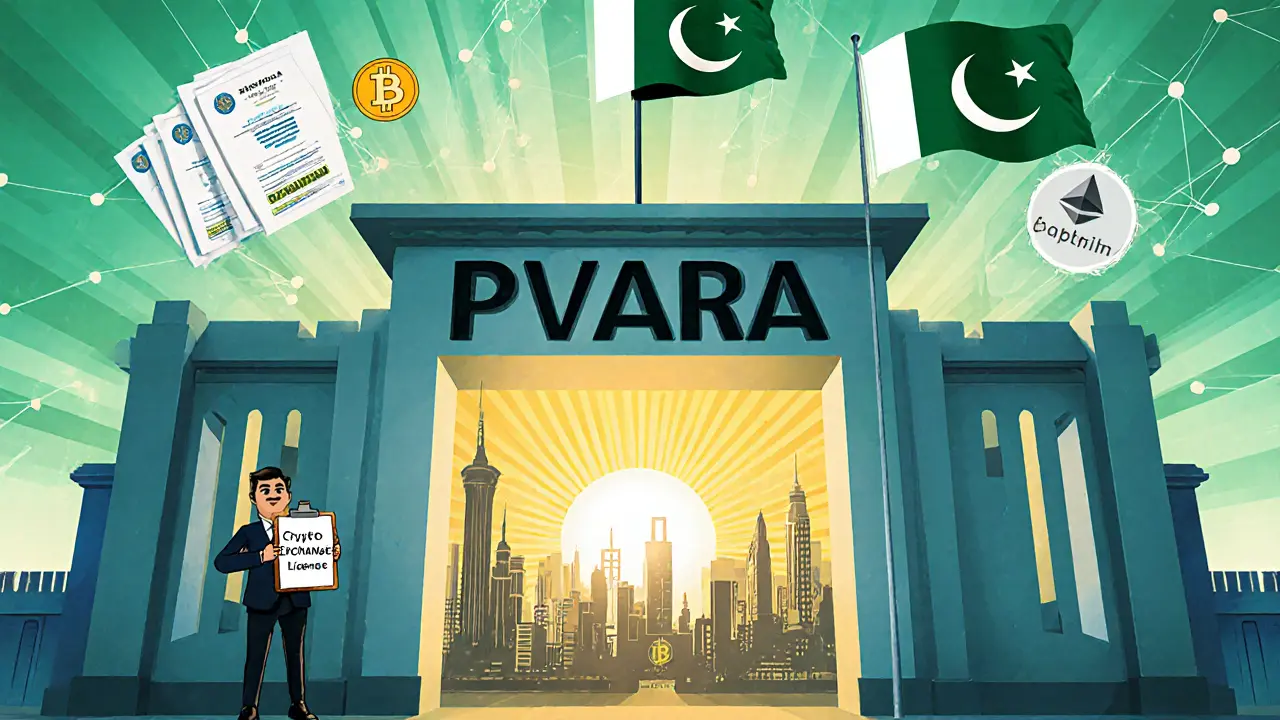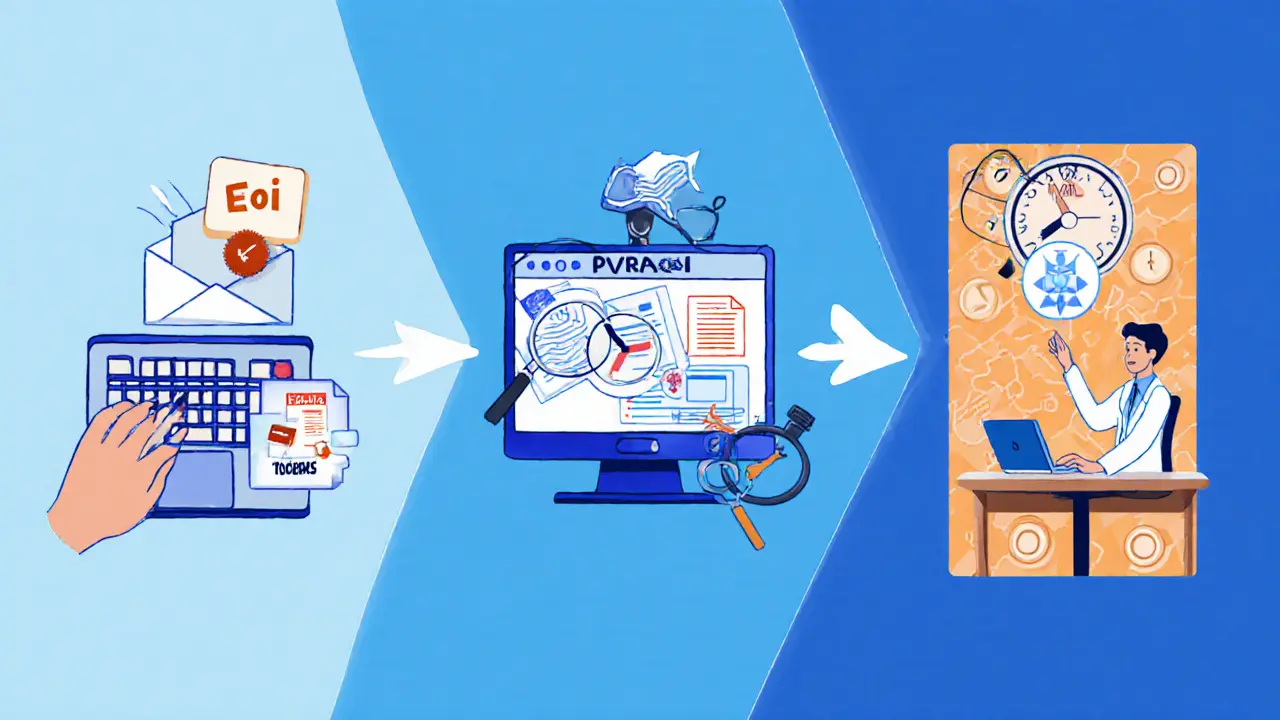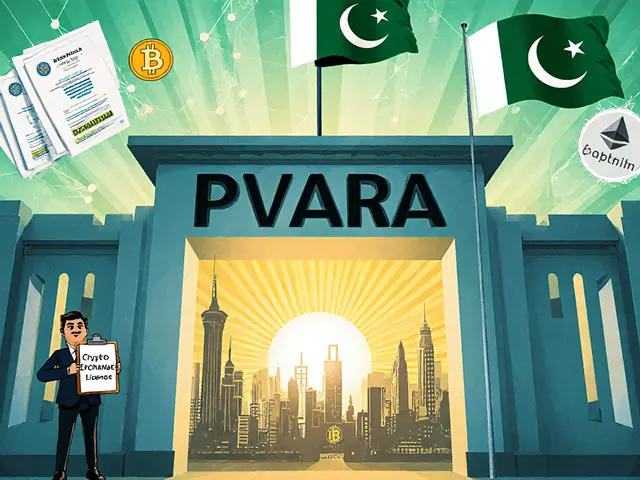How to Get a Pakistani Crypto Exchange License: Requirements & Step‑by‑Step Process

Looking to launch a crypto exchange in Pakistan? The country finally opened a formal licensing window in July 2025, but the path isn’t a straight line. Below you’ll find everything you need to know - from who can even apply to the exact paperwork, timelines, and the odd clash between regulators that could affect your launch.
What is PVARA and why does it matter?
Pakistan Virtual Asset Regulatory Authority (PVARA) is the federal body created by the Virtual Assets Ordinance2025 to oversee all virtual‑asset activities in the country. Chaired by Bilal bin Saqib, who also serves as Pakistan’s minister of state for crypto and blockchain, PVARA operates under International Monetary Fund (IMF), Financial Action Task Force (FATF) and World Bank standards. Its mandate covers licensing, AML/CFT supervision, and the development of sandboxes for Shariah‑compliant products.
In practice, PVARA is the gatekeeper for anyone who wants to run a cryptocurrency exchange, custody service, or payment processor targeting Pakistani users. Missing a step in its process can stall your project for months, or even lead to a denial of entry.
Who can apply? Eligibility at a glance
The regulator is deliberately selective. Only firms that already hold a licence from a recognised international authority may submit an Expression of Interest (EoI). The acceptable licences include:
- U.S. Securities and Exchange Commission (SEC) registration
- U.K. Financial Conduct Authority (FCA) authorisation
- European Union‑wide VASP framework approval
- United Arab Emirates Virtual Assets Regulatory Authority (VARA) licence
- Monetary Authority of Singapore (MAS) licence
If your firm does not already hold one of these, you’ll need to obtain it first - PVARA will not issue a domestic licence to a greenfield operator.
Step‑by‑step: The licensing workflow
- Submit an Expression of Interest (EoI): Draft a concise PDF, title the email ‘EoI VASP Licensing - [Company Name]’, and send it to the email address published on PVARA’s website. The EoI must include basic corporate data, existing licences, and a short business plan for the Pakistani market.
- Pre‑screening by PVARA: Within two weeks, the authority checks eligibility, confirms the foreign licence, and requests any missing details.
- Full application package: Upon clearance, you receive a secure portal link. Upload the complete set of documents listed in the checklist below (see next section).
- Technical & compliance review: PVARA’s AML/CFT unit, guided by the Financial Action Task Force (FATF) standards, validates KYC procedures, transaction monitoring tools, and cybersecurity controls. Expect at least one on‑site audit or remote code review.
- Regulatory sandbox (optional): If you plan to offer Shariah‑compliant tokens, you can apply to the sandbox for a limited‑time pilot. This route can shorten the overall timeline by up to three weeks.
- Final decision & licence issuance: After a minimum of three months from full submission, PVARA issues a "Virtual Asset Service Provider Licence" valid for two years, renewable upon satisfactory compliance reporting.

Documentation checklist - what to include
Missing even a single item can send your application back for clarification, adding weeks to the process.
| Document | Details required | Format |
|---|---|---|
| Company profile | Legal name, registration number, jurisdiction, ownership structure, board CVs | |
| Foreign regulator licence(s) | Full licence copy, regulator name, licence number, expiry date | |
| Business model for Pakistan | Target user segments, revenue streams, projected AUM, fiat‑on‑ramp partners | |
| Technology & security architecture | System flow diagram, encryption standards, incident‑response plan, third‑party audit reports | |
| AML/CFT policies | KYC workflow, sanctions screening, transaction monitoring thresholds, SAR reporting process | |
| Financial statements | Audited statements for the past two fiscal years, profit‑and‑loss, balance sheet | |
| Shariah compliance plan (if applicable) | Fatwa endorsement, governance framework, intended token structures |
Timeline, fees and ongoing compliance
Typical milestones look like this:
- EoI submission: Day0
- Pre‑screening outcome: 10‑14days
- Full documentation upload: Within 30days of pre‑screening approval
- Review period: 60‑90days (includes technical audit)
- Licence issuance: Minimum 3months from complete file receipt
Fees are modest by global standards: a non‑refundable application fee of PKR500,000 (≈US$1,800) plus an annual licence charge of PKR1million (≈US$3,600). Late‑submission penalties apply after the 30‑day upload window.
Once licensed, you must submit quarterly compliance reports covering AML/CFT metrics, transaction volumes, and any changes to ownership. PVARA also conducts random on‑site inspections - failure to cooperate can result in suspension or revocation.
The regulatory paradox: PVARA vs. State Bank of Pakistan
While PVARA is actively granting licences, the State Bank of Pakistan (SBP) still classifies cryptocurrencies as illegal under banking law. That means:
- Traditional banks cannot hold, transfer, or settle cryptotransactions for licensed exchanges.
- Payment processors must rely on alternative settlement routes - often via local money‑transfer operators or specialised fintech partners.
- Any attempt to open a bank account for the exchange’s fiat reserves may be rejected, forcing firms to keep fiat in offshore accounts or use crypto‑friendly neobanks.
The clash creates operational friction, but most early entrants have navigated it by partnering with licensed remittance companies that already have SBP approval for cross‑border fiat flows.

Opportunities and challenges for crypto firms
Pakistan’s market holds over 220million people, a large un‑banked segment, and a diaspora that sends roughly $30billion in remittances annually. For a compliant exchange, that translates into:
- Potential to capture a sizable share of crypto‑based remittance traffic.
- Room to develop Shariah‑compliant token offerings, a niche that few global players have targeted.
- Access to a growing pool of tech talent familiar with fintech and blockchain.
On the flip side, firms must wrestle with:
- Regulatory uncertainty - the SBP‑PVARA misalignment could tighten further if the government revises banking rules.
- Infrastructure constraints - the IMF has flagged Pakistan’s plan to allocate 2,000MW for Bitcoin mining as risky, meaning electricity costs may remain volatile.
- Political risk - any shift in the Senate’s stance on the Virtual Assets Bill could introduce new compliance layers.
Overall, the reward‑to‑risk ratio looks attractive for players who can move quickly, stay compliant, and adapt to evolving policy directions.
Quick reference guide
| Aspect | Details |
|---|---|
| Regulating body | PVARA (Pakistan Virtual Asset Regulatory Authority) |
| Key international standards | FATF AML/CFT, IMF guidelines, World Bank ESG criteria |
| Eligible foreign licences | SEC, FCA, EU VASP, VARA, MAS |
| Application fee | PKR500,000 (≈US$1,800) |
| Licence validity | 2years, renewable |
| Minimum processing time | 3months from full submission |
Frequently Asked Questions
Can a startup without a foreign licence apply?
No. PVARA only accepts applications from Virtual Asset Service Providers that already hold a recognised licence from the SEC, FCA, EU VASP framework, VARA or MAS. You would need to secure one of those licences first.
What happens if the State Bank of Pakistan blocks my fiat account?
Most licensed exchanges work around this by partnering with SBP‑approved remittance firms that can handle fiat settlements. Alternatively, you can keep fiat reserves in offshore accounts linked to a licensed payment gateway.
Is there a sandbox for Islamic finance products?
Yes. PVARA runs a dedicated regulatory sandbox that allows firms to pilot Shariah‑compliant tokens and tokenized assets for up to 12months before full licensing.
How long does the AML/CFT audit take?
The technical audit usually lasts 2‑3weeks, but PVARA may request additional evidence, extending the timeline. Plan for at least 6weeks total for the compliance review stage.
What are the renewal requirements?
Renewal requires an updated AML/CFT report, audited financials for the preceding year, and proof that the foreign licence remains active. The renewal fee is the same as the annual licence charge.
With the right paperwork, a clear roadmap, and an awareness of the SBP‑PVARA tug‑of‑war, you can secure a Pakistan crypto exchange license and tap into one of South Asia’s most promising digital‑asset markets.

Debra Sears
Reading through the licensing roadmap, it’s clear the process is both thorough and a bit intimidating. The dual oversight by PVARA and the SBP creates a unique set of challenges that newcomers need to anticipate. It’s helpful to see the checklist laid out step‑by‑step, especially the emphasis on AML/CFT compliance. Having a clear timeline can also prevent those costly delays that many firms have experienced.
Hope this guide eases some of the stress for anyone prepping their application.
Andrew Lin
Honestly, why is everyone acting like this is some exotic quest? The US already has the strongest crypto regs, and if foreign firms want in, they should just get an SEC registration first. No need for all this extra Pakistani red‑tape – it’s just bureaucratic circus! Get your paperwork in order or stay out.
Stop whining about "opportunities" when you can’t even meet the basic licensing criteria.
Matthew Laird
It’s sad to see so many companies chasing profit while ignoring the ethical implications of operating in a market where the central bank outright bans crypto. Even if PVARA grants a license, the underlying conflict with the SBP shows a lack of moral clarity. Investors should ask themselves whether they want to be part of a system that skirts fundamental financial regulations for short‑term gains.
Think beyond the hype – real value comes from responsible innovation, not regulatory loopholes.
Caitlin Eliason
Wow, this whole licensing saga reads like a thriller! 🎬 The drama of navigating two regulators, plus the sandbox for Shariah‑compliant tokens, is pure edge‑of‑your‑seat material. 📜 If you can survive the paperwork, you might just unlock a massive untapped market. 💡 Just remember: every step you clear is a badge of honor in this high‑stakes game.
Richard Bocchinfuso
i cant believe how many people dont even read the fine print. the licence fee alone is a massive hit for a startup. plus, the whole "must have a foreign licence" rule is just a way to keep out a lot of impromptu players. if you dont have an sec or fca paperwork, youre basically outta luck.
just sayin.
Nicholas Kulick
Key takeaways:
– Only firms with SEC, FCA, EU VASP, VARA, or MAS licences are eligible.
– The application fee is PKR 500,000, plus an annual PKR 1 million charge.
– Minimum processing time is roughly three months from full submission.
– Ongoing compliance includes quarterly AML/CFT reports and random inspections.
Jason Wuchenich
Don’t get discouraged by the hurdles – every step you complete builds credibility. Think of the sandbox as a sandbox for innovation; it can actually speed up your launch if you target Shariah‑compliant products. Keep the team focused, stay on top of the documentation, and you’ll be positioned to capture a growing market.
Stay optimistic and keep pushing forward!
Kate O'Brien
Listen, the whole thing feels like a staged distraction. They let you think you’re getting a legit licence while the real power sits with people pulling strings behind the scenes. Remember the IMF’s warning about Bitcoin mining – they’re not just concerned about energy, they want to keep control. Watch out for hidden agendas; the “sandbox” might just be a testing ground for monitoring tools.
Ricky Xibey
Sounds like a bureaucratic nightmare.
Anna Engel
Oh, great, another checklist that promises to make everything simple. Because we all know how smoothly regulatory bodies work in practice. Just follow the steps, fill the forms, and watch the magic happen – as if any of this ever goes according to plan. 🙄
Marcus Henderson
It is evident that, despite the complexities inherent in the dual‑regulatory environment, diligent adherence to the stipulated procedures will likely result in a favourable outcome. The process, though extensive, aligns with internationally recognised standards, thereby providing a robust framework for operational integrity. By maintaining meticulous documentation and complying with AML/CFT mandates, applicants can demonstrate their commitment to regulatory compliance.
Ken Pritchard
Let’s keep the conversation constructive. If you’re building a team, make sure to involve both compliance experts and local partners who understand the SBP’s stance. Sharing best practices across projects can help smooth out the friction points. Collaboration, rather than competition, will benefit the whole ecosystem.
Jasmine Kate
This whole licensing drama is just another example of how fragile the crypto world has become. Every new rule feels like a knife aimed at innovators, and the constant back‑and‑forth between PVARA and the SBP is pure chaos. If you can’t even open a basic fiat account, how are you supposed to run a serious exchange? It’s a disaster waiting to happen.
Franceska Willis
Okay, so the doc list is kinda long but not imposible... just make sure to have all the PDFS, especially the tech architecture diagram, 'cause they love that stuff. Also, dont forget the Shariah fatwa if youre doing islamic tokens – without it youre just another meme project. Lol, good luck!
Heather Zappella
The detailed breakdown of the licensing workflow offers a clear roadmap for firms seeking to enter the Pakistani market. First, the Expression of Interest (EoI) serves as a crucial preliminary step, allowing regulators to verify the applicant’s eligibility based on existing foreign licences. This initial verification typically occurs within a two‑week window, after which applicants receive guidance on the subsequent documentation required. The comprehensive checklist, encompassing corporate profiles, technology architecture, AML/CFT policies, and financial statements, underscores the regulatory emphasis on transparency and risk mitigation. Notably, the inclusion of a Shariah compliance plan for Islamic finance products reflects PVARA’s commitment to fostering culturally relevant innovations. The optional sandbox program can accelerate market entry for tokenised assets, provided that firms demonstrate robust security protocols. Throughout the technical and compliance review phases, PVARA’s auditors may conduct on‑site inspections or remote code reviews to assess cybersecurity measures and transaction monitoring capabilities. Applicants should anticipate a minimum processing period of three months from the receipt of a complete file, although delays may arise if documentation is incomplete or if additional evidence is requested. Financial considerations include a non‑refundable application fee of PKR 500,000 and an annual licensing charge of PKR 1 million, both of which are modest relative to global standards. Ongoing compliance obligations-quarterly AML/CFT reporting, periodic financial audits, and potential random inspections-ensure that licensed entities maintain high operational standards. Importantly, the discord between PVARA and the State Bank of Pakistan introduces an operational challenge, as traditional banking services for fiat settlement remain restricted. Successful market entrants typically navigate this obstacle by partnering with SBP‑approved remittance firms or utilising offshore banking solutions. In summary, while the licensing process is rigorous, it provides a structured pathway for compliant firms to tap into Pakistan’s sizable unbanked population and burgeoning remittance flows.
Sal Sam
Building on the comprehensive overview, it’s critical to note that the AML/CFT module leverages a risk‑based approach, integrating transaction‑monitoring algorithms with real‑time sanctions screening. Deploying a modular KYC engine that interfaces via API with the centralised PVARA portal can streamline verification workflows, reducing audit friction. Moreover, employing end‑to‑end encryption (AES‑256) for data at rest and TLS 1.3 for data in transit aligns with the stipulated cybersecurity standards. When configuring the sandbox, ensure that token smart contracts adhere to ERC‑20 or ERC‑1400 specifications, as the regulator favours proven token standards for auditability. Finally, document every governance decision within a change‑management log to satisfy the post‑licensing review requirements.
Moses Yeo
Consider, however, the paradoxical nature of regulatory frameworks, which simultaneously strive for innovation‑fostering openness, yet impose stringent compliance burdens, thereby creating an environment where only the most resource‑rich entities can feasibly participate, leading, in effect, to market concentration, and, consequently, to a reduction in the diversity of services offered to the end‑user, which, in turn, may undermine the very objectives of financial inclusion that the regulators purport to champion.
Lara Decker
While the guide is thorough, it fails to address the real risk of regulatory capture. The overlap between PVARA and the SBP could lead to inconsistent enforcement, making compliance a moving target. Prospective entrants should factor in this volatility when assessing long‑term viability.
Mark Fewster
It’s encouraging to see such detailed guidance; having a step‑by‑step process helps demystify what can otherwise feel overwhelming. The emphasis on documentation and ongoing reporting is essential for maintaining transparency and building trust with both regulators and users.